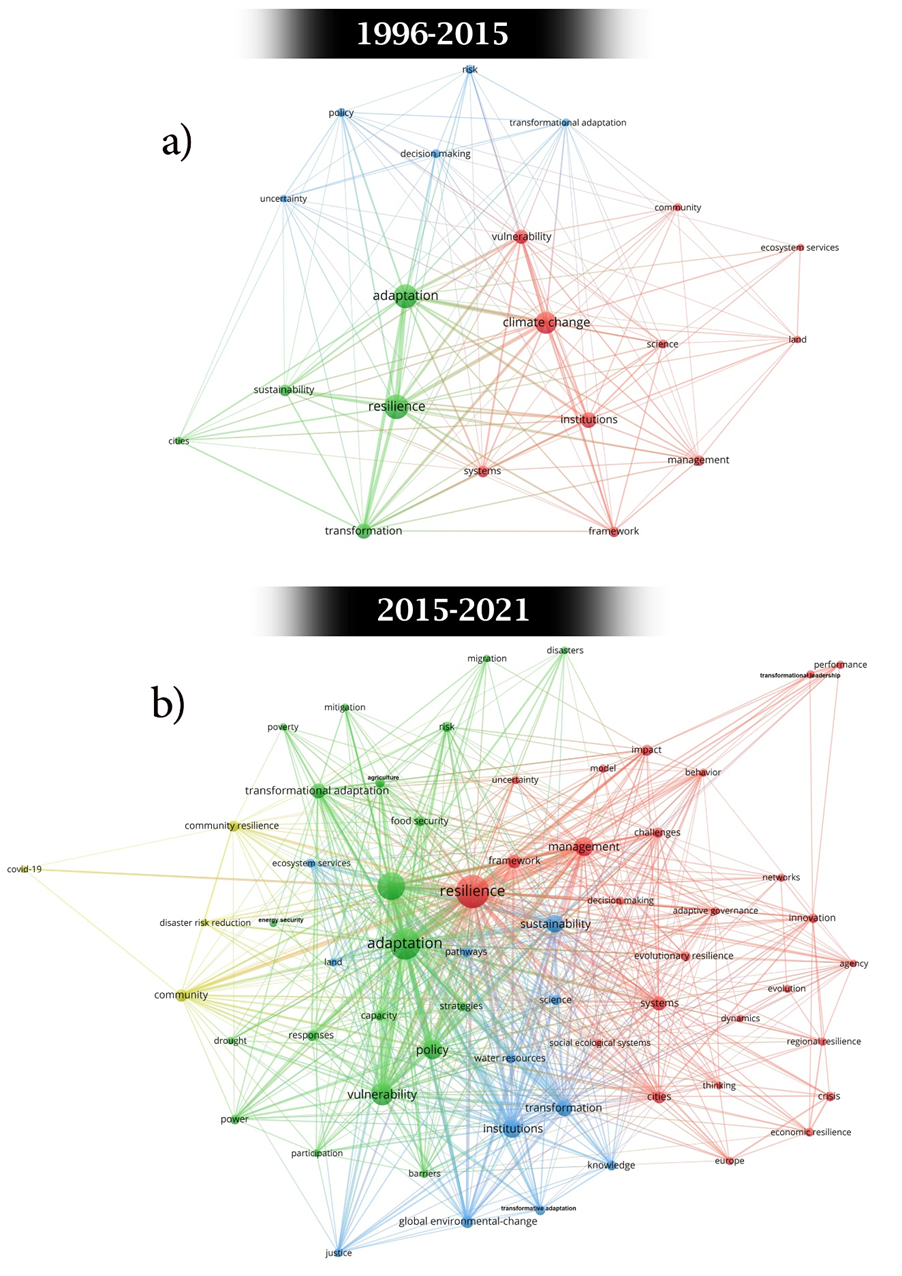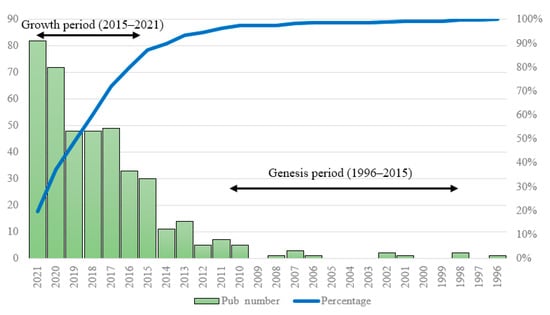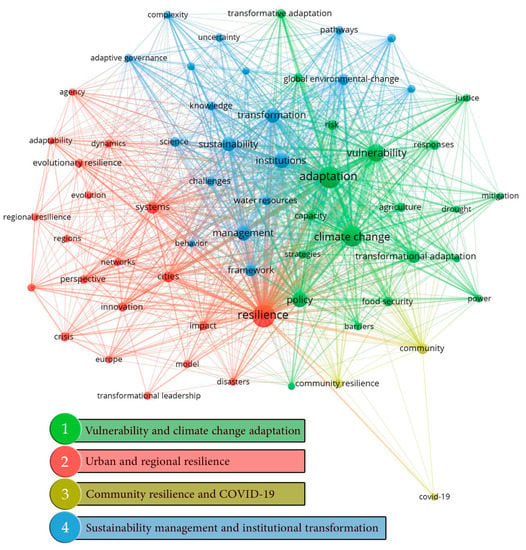2. Publication Trends
Figure 1 is a Pareto chart indicating the transformative resilience publications trend for 1996–2021. Since the publication of the first paper in 1996, about 415 papers have so far been published on this subject based on the Web of Science search. This figure demonstrates an irregular publication trend, with the number of publications increasing exponentially since 2015. Based on the cumulative percentage line, about 50% of publications were disseminated in the last three years. The study years (1996–2021) are classified into two sub-eras based on the development speed of publication directions. The initial era encompasses the years from 1996 to 2015 when the publication speed was slow and fluctuated. In sum, only 53 (13% of the sample) papers were published in this period. One explanation of this background is that the term transformation has not been well-positioned in international policy and scientific discourses on “development, climate adaptation, and disaster risk reduction” [
2]. Despite some underlying academic efforts in characterizing transformation and the associated necessities to navigate the shift toward fundamental transformative resilience [
23,
24,
54,
55,
56], many resilience initiatives have been limited to the understanding of the concept as reactive absorptive coping or moderative incremental adaptive capacities aiming at managing the impacts of disasters or changes, and gradually streamlining available standards and adjusting to keep the continuity of systems, respectively [
57].
Figure 1. Year Pareto chart for transformative resilience publications for 1996–2021. Note that the literature search was done in early October 2021, and more publications are expected to be published this year.
In the second period (2015–2021), the adoption of the landmark UN agendas of the “Sustainable Development Goals2 [
58], the “Paris Agreement” [
59], and the “New Urban Agenda” [
60] highlighted the vital need for fundamental changes in development trajectories, climate change adaptation pathways, and disaster risk reduction strategies. The discourses on transformation have also been supported by UN science-for-policy reports such as the “IPCC’s Special Report on Managing the Risks of Extreme Events and Disasters to Advance Climate Change Adaptation” (SREX) [
61] and the “UNISDR’s 2015 Global Report on DRR (GAR)” [
62]. Therefore, by re-positioning transformation in resilience science and policy discourses, the number of related documents increased drastically, with 362 papers being published (87% of the sample) in the second period.
3. Core Subjects, Journals and Authors
As of September 2021, 415 studies have been published that are relevant to transformative adaptation or transformative resilience, relying on the terms considered by authors in titles, abstracts, and keywords. The analyzed publications largely comprise academic journal articles (N = 340; 81.9%) while also containing proceeding papers (N = 27; 6.5%), reviews (N = 42; 10.1%), and book chapters (N = 6; 1.4%). Based on the WOS database, the main subject areas belong to environmental studies (N = 181; 44%), geography (N = 41; 10%), business economics (N = 34; 8%), urban studies (N = 28; 7%), and public administration (N = 28; 7%). The vast majority of literature relates to social-environmental studies, indicating that enhancing transformative resilience is a case to challenge the established systems that undermine environmental, social, and economic sustainability [
29].
Most of the published literature comes from the United States (N = 125; 30%), followed by the United Kingdom (N = 70; 17%), Australia (N = 70; 17%), Germany (N = 34; 8%), and Canada. Accordingly, the principal players of transformative resilience discourses are three Global North countries, the USA, the UK, and Australia, and the contribution of Global South countries has been negligible. The closest research collaboration also belongs to the top three countries. Although the evidence of social-environmental inequalities and vulnerabilities supporting the need for a paradigm shift in resilience planning and practice are dominant in the Global South, the applicability of the developed concepts, tools, and indicators of transformative resilience in the Global North to cities in the Global South is still a challenging issue. This is because transformative resilience by nature is a highly context-dependent term that necessitates the development of evidence-based and inclusive approaches [
8,
63]. The funding agencies of the field are the four institutions from the USA (National Science Foundation), EU (European Commission), UK (UK Research Innovation), and China (National Natural Science Foundation of Chania), indicating that transformative resilience discourses demand shifting unjust socio-political relations as well as processes within which they developed and delivered [
64].
The journals that have published the most papers on this topic include “Sustainability” (N = 22; 5%), “Global Environmental Change” (N = 17; 4%), “Environmental Science & Policy” (N = 15; 4%), and “International Journal of Disaster Risk Reduction.” The leading organizations are Stockholm University (N = 10; 2.4%), University of Cambridge (N = 10; 2.4%), University of Melbourne (N = 10; 2.4%), Monash University (N = 10; 2.4%), and Arizona State University (N = 9; 2.1%). The most published authors are Carl Folke (N = 6), Gina Ziervogel (N = 5), Matthew Colloff (N = 5), and Christi Wamsler (N = 5). These are distinguished researchers in the field of resilience and its associated concepts, including adaptive and transformative capacities to steer the paradigm shift toward more sustainability and resilience concerning growing uncertainties and changes in world dynamics.
4. Research Subject Areas and Their Transformation
4.1. Subject Areas
The analysis highlighted four primary clusters (
Figure 2). The node size represents the frequency of keywords. The thickness of the links between nodes is proportional to the strength of connections between them. As
Figure 2 displays, some other terms such as institutions (N = 62, 3.8%), policy (N = 61, 3.7%), management (N = 55, 3.2%), and transformation (N = 52, 3%) also represent high values of occurrence, indicating that they are considered as enabling forces of transformative pathways to navigate the paradigm shift toward fundamental transformative resilience in the relevant discourses [
66,
67,
68,
69]. Similarly, the high link strength of these terms reveals that they are considerably interconnected to other keywords. The most popular keywords, including resilience, adaptation, policy, management, and institutions, are placed close to the edges of the clusters, commenting that they cut across all themes. This is because transformative resilience is a multidisciplinary and multifaceted concept calling for an intentional shift in institutional structures and planning mechanisms to predispose cities to transform themselves against uncertain circumstances. [
8,
29].
Figure 2. The term co-occurrence analysis output map.
The first (green) cluster in our analysis contains terms related to “vulnerability to climate change” [70,71], which is often linked with the “climate change adaptation” concept [64,72] in the context of climate-induced hazards, including drought [38,73], food security [74,75], and global warming [72,76]. This cluster can be linked to the social-ecological discourse of resilience that defines transformation as radical policy and structural changes of social-ecological systems (SESs) to establish new trajectories for SESs and secure the maintained “well-being” of humans and the ecosystem services [54,77–79].
The second (red) cluster consists of terms that are centralized around the resilience of urban [
80,
81] and regional [
82,
83] systems by focusing on innovative [
84,
85], dynamic [
86,
87], and evolutionary [
55,
88] perspectives to reduce the impacts of natural or climate-induced disasters or crises [
89,
90,
91]. This cluster is mainly related to the
disaster risk reduction (DRR) discourse of resilience that conceptualizes transformative adaptation as radical policy and structural changes of urban and regional systems to outline new strategies and capacities and deliver justice, equity, and long-term development [
23,
24,
56].
The third (blue) cluster analysis comprises terms that emphasize the sustainability transformation of [
92,
93,
94] of institutions [
95,
96,
97] and management [
98,
99] structures in transformative resilience planning and practice. This cluster can be connected to the
sustainable development discourse of resilience that links transformation to the institutional arrangements and governance structures of existing risk management systems. The main focus is to develop new frameworks, knowledge, and science to improve decision-making processes and adaptive governance pathways that enable the transition toward disaster risk reduction, long-term resilience, and sustainable communities in the context of increasing complexity and uncertainty associated with global environmental change [
29,
79,
100].
The fourth (yellow) cluster is an emerging theme in transformative resilience discourses that only contains a few terms related to community resilience [
101,
102] in the context of COVID-19 and its associated challenges [
103,
104,
105].
4.2. Transformation of Research Subjects over Time
As Figure 3 indicates, the first group includes the research conducted from 1996 to 2015 (N: 53, 13%). The second group encompasses a greater number of studies published from 2015 to 2021 (N: 362, 87%). Overall, the three terms, “resilience,” “adaptation,” and “climate change,” have been the most frequently co-occurred keywords in both periods. The first period can be divided into two sub-periods: the genesis (1996–2000) and development (2000–2015). In the genesis phase (1996–2000), adaptation is the most used term for the concept of resilience that appears in multiple disciplines, such as complex systems, sustainability, and urban scale risks [
106,
107,
108]. In the development phase (2000–2010), the literature distinguishes between adaptive and transformative capacities for resilience and gravitates to the transformation of multiple systems and institutions via bounce-forward frameworks and approaches [
54,
109,
110]. Nevertheless, the field was still in its infancy during the first period, and only a few underlying themes emerged in the analysis. Overall, the first period includes those narratives that have mainly focused on improving the resilience of complex socio-ecological systems such as cities by adaptation measures to drive the required transformation for medium to long-term resilience (green cluster). Another focus area has been examining the vulnerability of different systems (e.g., ecosystems, communities, land, etc.) by analyzing institutional arrangements, frameworks, and management to handle the challenges posed by climate change (red cluster). However, there are limited transformational pathways for capacitating policy and decision-makers to guide the transition toward disaster risk reduction and long-term resilience (blue cluster).
In the second period (2015–2021), the number of publications and the thematic focus of the field increased remarkably. As mentioned, research concerning resilience (N = 149, 13%), adaptation (N = 132, 9.7%), and climate change (N = 108, 7.7%) have been the priority subject areas of the literature during this period. While institutions and transformation were the fourth and fifth frequent terms in the first period, they were replaced with vulnerability and policy terms in the second period, indicating the entanglement of the concept of vulnerability with the vision of fundamental transformative resilience and the articulation of the field in policy documents [
24,
111,
112]. New priority research topics emerged in this period to underpin a fundamental change in transformative resilience thinking and planning, making it more just [
113], evolutionary [
114], and inclusive [
115]. With more research being published, the intellectual foundation of the field augmented, and new themes with high centrality values emerged. By addressing the resilience of what question (conceptualization), the field started to embrace new concepts to challenge the established development and risk management trajectories and develop transformational mechanisms to lead to innovative practices toward sustainable resilience [
116,
117]. Similarly, complex and successive changes in world dynamics transferred the field to new contexts (contextualization). For instance, the COVID-19 pandemic placed cities across the world at the forefront of disaster reduction and appeared as an emerging research priority for transformative resilience discourses [
103,
118]. In addition, research on transformative resilience has been enriched by capacity and performance-based frameworks (operationalization) to link its grand theories to ground-level evidence of which interventions should be considered to build and boost fundamental transformative resilience [
12,
119,
120]. As expected, the structure and distribution of key topics in this cluster are compatible with the patterns of the whole period. However, some keywords were repositioned from the blue (Sustainable development transformation) to the red cluster (Transformative DRR) (Figure 3). One explanation of this trend is that transformative resilience narratives are increasingly considered a boundary object in the science-practice interface and between multiple academic disciplines, sectors, and scales [
46,
121].




